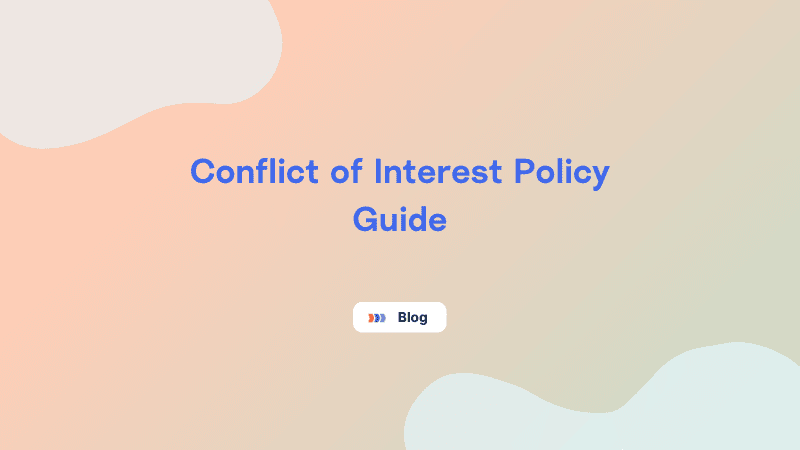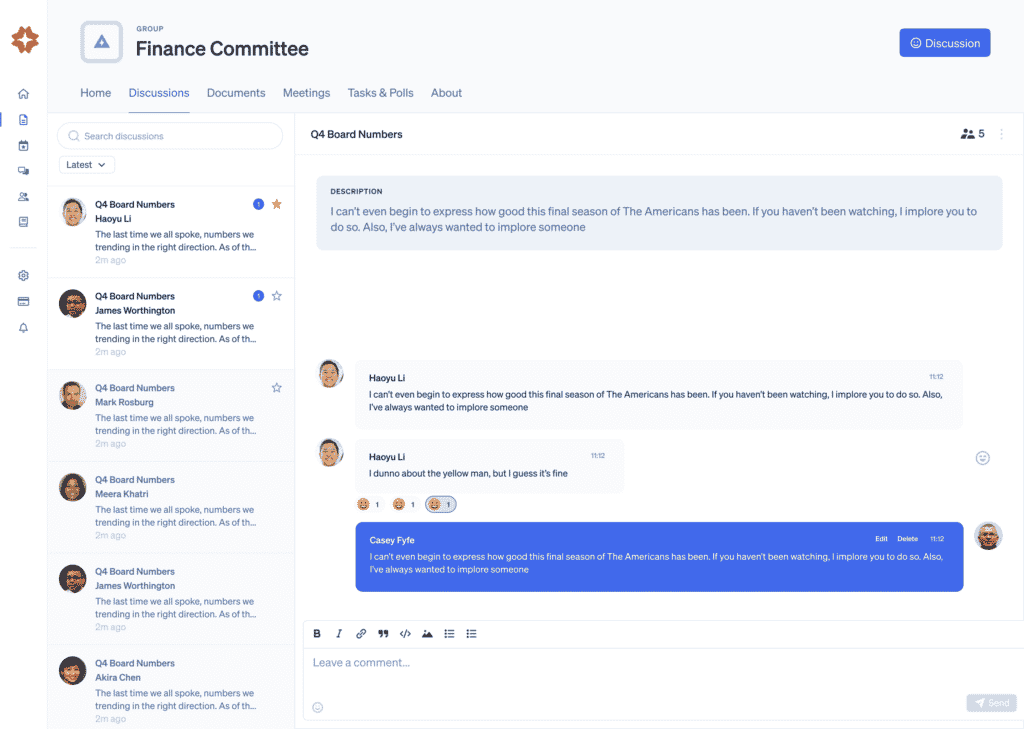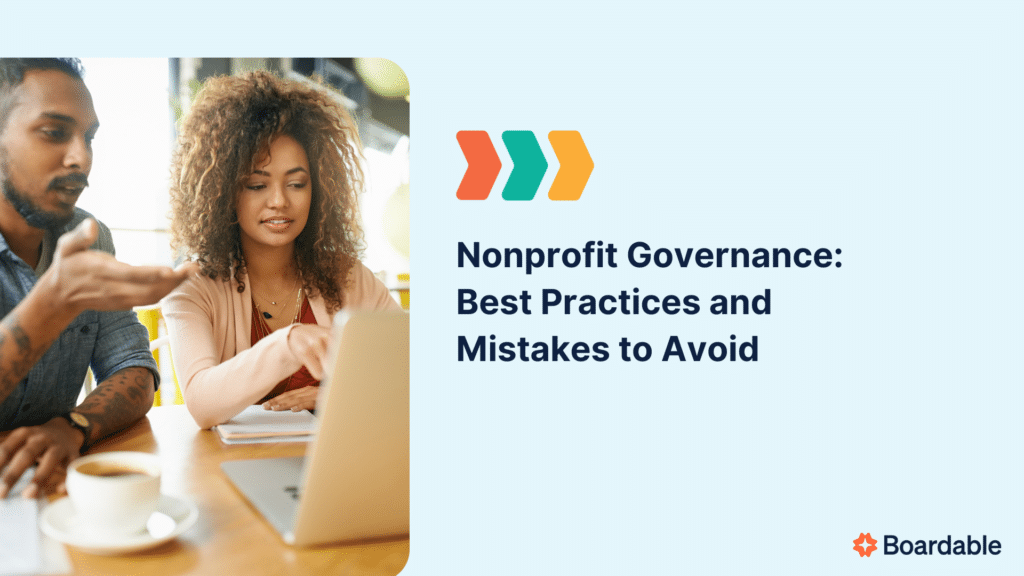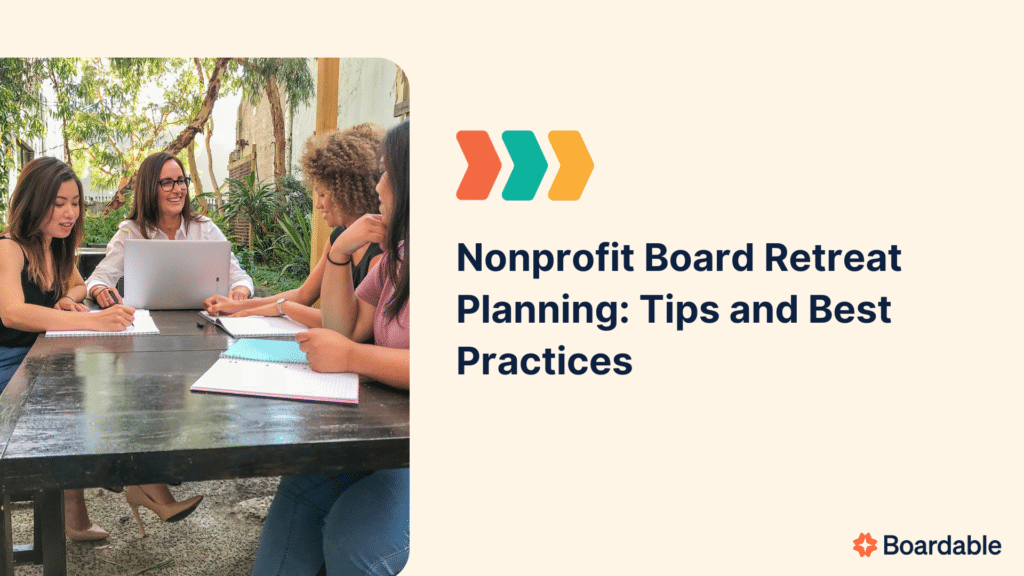A conflict of interest policy is an official document that outlines the procedures for team members when a conflict occurs between their personal interests and the interests of the organization. The policy sets boundaries around potential employee and board member conflicts that may arise to prevent legal liabilities and discordance between a company and its workers.
For board members, in particular, a conflict of interest policy prevents them from benefitting immorally from their board service. Board members are responsible for governing their organizations in an ethical manner, and as part of their roles, they’re supposed to act in the best interests of their organizations, not their personal interests.
Undisclosed conflicts of interest will compromise public trust, so an organization with conflicts of interest will quickly lose credibility. That’s why a dedicated policy is necessary for any organization that wants to gain momentum in its sector.
To help minimize challenges, we’ve compiled this guide, which covers everything you need to know about the importance of a well-written conflict of interest policy and how you can develop your own fool-proof policy. Here’s what we’ll cover:
- What to Include in a Conflict of Interest Policy
- Conflict of Interest Policy FAQs
- Conflict of Interest Policy Template
- Pointers to Implement Your Conflict of Interest Policy
At Boardable, we understand that a lot goes into managing and leading an organization, particularly for the board. To help you protect the organization that you work so hard to lead, this guide will explore everything you need to avoid conflicts of interest by developing a strong policy that covers all your bases. That way, you can spend more leading your organization toward greater outcomes, not just keeping the doors open. Let’s dive in.

What to Include in a Conflict of Interest Policy
At its core, a board member conflict of interest policy should (a) require those with a conflict (or a potential conflict) to disclose it, and (b) prohibit any board members from voting on any matter in which they have a personal conflict.
To cover your bases, here are some of the details you should include in your conflict of interest policy:
- A statement about an individual’s duty to disclose any conflicts of interest
- The process for reviewing potential conflicts of interest
- Details about disciplinary actions for violating the policy
- A disclosure statement that’s signed by all board members, staff members, and other key personnel each year
Including all the relevant information in your policy will help address any conflicts before they arise. When it comes to drafting your conflict of interest policy, your organization’s lawyer can also help. Many state agencies or offices also have specific guidelines about how to word your policies and what to include.

Conflict of Interest Policy FAQs
If you’re writing your conflict of interest policy from scratch or you need to revamp your current one, it’ll help to revisit some of the basics to ensure that nothing gets missed. Let’s review some common questions that organizational leaders have about conflicts of interest.
What is an example of a conflict of interest?
In theory, the idea of a conflict of interest seems fairly vague without a visual representation, which is why it can be helpful to review some common, concrete examples. There are plenty of examples that we can borrow from other organizations. We’ve all heard horror stories like:
- A nonprofit is paying a board member under the table to conduct a side business.
- A staff member has a relationship with someone in an authoritative position at the company.
- A nonprofit board member’s company secures a lucrative contract with the nonprofit for services that don’t seem wholly necessary.
- An employee is using company equipment to support an external business venture.
- A company leader owns shares of a competitor’s stock.
- A board member has knowledge about an upcoming company merger, acquisition, or sale.
While these examples aren’t necessarily outlawed, anything that qualifies as a conflict of interest possesses the appearance of impropriety and should be avoided at all costs.
When an employee or board member understands that one of these conflicts exists, they should elevate it to the appropriate leader at the organization. Otherwise, they’re putting the organization’s credibility at risk.
Is a conflict of interest policy required?
Yes, having a conflict of interest policy is legally required under federal law and some state laws. Some states and local officials take it a step further and have stipulations regarding what type of information must be included. While there may be regulations put in place for corporations, these laws more so apply to nonprofits, since the public keeps a close eye on them to ensure they’re managing their organizations in an ethical manner and are worthy to maintain tax-exempt status.
For example, New York offers a great example of built-out laws regarding conflicts of interest policies for nonprofits. As part of the Nonprofit Revitalization Act of 2013, New York’s law states that:
“Every [nonprofit] corporation shall adopt a conflict of interest policy to ensure that its directors, officers and key employees act in the corporation’s best interest and comply with applicable legal requirements.”
The act also provides guidance for drafting a policy, saying that it should include the following details:
- A definition of what constitutes a conflict of interest
- Procedures for disclosing a conflict of interest to the appropriate leaders
- A requirement that the person with the conflict should not be present at or participate in deliberation or vote on the matter
- A prohibition against any attempt by the person to improperly influence the deliberation or voting on the matter related to the conflict
- A requirement that the existence and resolution of the conflict of interest be documented in the corporation’s records
- Procedures for disclosing, addressing, and documenting related transactions
In terms of federal laws, the Form 990 that nonprofits fill out annually asks whether the nonprofit has a written conflict of interest policy and how the organization determines whether board members have conflicts. It also requires the nonprofit to outline its process for managing such conflicts.
Corporate laws are not quite extensive in terms of conflict of interest policies, but regulations may apply. Be sure to check for any applicable local, state, and federal requirements.
How can you avoid conflicts of interest?
When it comes to avoiding potential conflicts of interest, we can learn best from others’ experiences. While we reviewed common examples across the for-profit and nonprofit sectors, here are some common ways to deal with conflicts of interest as they come up or avoid them in the first place:
- Both corporate and nonprofit boards commonly devote one board meeting per year to discussing conflicts of interest that may have arisen.
- Many boards make the conflict of interest policy easily accessible by housing it in a central location online. Boardable enables organizations to store key documents in a mobile-accessible Document Center, so board members and other users can reference the policy at any given moment. Not to mention, our E-Signature tool makes it incredibly easy to sign this document.
- For board and staff members alike, experienced organizations don’t treat the policy as a “one-and-done” deal. Instead, they revisit the policy and tweak it as necessary.
- Some organizations also do compliance training sessions where they discuss hypothetical situations—including nuances of conflict and how the board would handle it.
However you handle conflicts of interest, do so quickly. The longer you wait, the more of an issue they can become both internally and externally. Implementing these tried-and-true methods will go a long way to maintaining an ethical team and keep your credibility intact when it comes to dealing with conflicts of interest.

Conflict of Interest Policy Template
We’ve covered the basic components of a well-written conflict of interest policy. Now, let’s see what all that information looks like when pieced together.
Check out our conflict of interest policy sample and feel free to model your own after it.
Disclaimer: This conflict of interest policy sample is meant only to provide general guidelines. It may not take into account all applicable local, state, and federal laws and should instead be used to give a general idea of what a generic policy may look like. Neither the author nor Boardable will assume any legal liability that may arise from using this sample template.
Breaking Down Our Conflict of Interest Policy Sample
If you’re unable to click through to the template above, here’s the text from it, so you can still leverage our conflict of interest policy sample to kickstart your own draft:
Conflict of Interest Policy Sample
[Organization Name]
Article I – Purpose
The purpose of this policy is to protect the interests of [organization name] by: (a) preventing the personal interest of the Board, Employees, and Independent Contractors from interfering with their duties to the organization and (b) avoiding any unethical financial, professional, or political gain on the part of such individuals. The intent of this policy is to supplement, not replace, any applicable federal, state, or local laws regarding conflicts of interest.
Article II – Persons Concerned
This statement applies to Board Members, Officers, and all Employees who can influence the governance and actions of [organization name]. This includes anyone who makes financial decisions, might be referred to as “management personnel,” or have proprietary information regarding [organization name].
Article III – Procedures
1. Duty to Disclose
Each Member, Director, Officer, Employee, and any other Interested Person is under an obligation to disclose the existence or potential existence of a Conflict of Interest as it arises.
2. Investigating Conflicts
When a potential Conflict of Interest is disclosed, the Governing Board will then provide the individual with an opportunity to disclose all material facts. The Board will collect all pertinent information and question the involved parties. If it turns out that a conflict does not exist, the inquiry will be documented but no further action will be taken.
3. Addressing a Conflict of Interest
If the Board determines that a conflict of interest exists, they will take the appropriate actions to address the conflict. This may include (but not be limited to): (a) prohibiting any Interested Parties from voting on any matter related to said Conflict of Interest or (b) terminating employment with [organization name].
Affected parties both within and outside of [organization name], including shareholders, directors, employees, and independent contractors, will be notified. If the Conflict of Interest in question involves a member of the Board, that individual will be excused from deliberations.
4. Disciplinary Action
All conflicts of interest will be reviewed on a case-by-case basis. The board has full discretion to deem what disciplinary action is appropriate and necessary for disclosed conflicts of interest.
If the governing officers reasonably believe a member or staff member failed to disclose an existing or possible Conflict of Interest, it shall inform the individual of the rationale for such belief and grant the individual an opportunity to explain the alleged failure to disclose the Conflict of Interest.
After hearing the individual’s response and investigating further as warranted by the circumstances, the governing officers may take appropriate disciplinary action, including removal from the position at the organization.
5. Notice of Annual Statements
Every Member, Director, Officer, Employee, and any other Interested Person must sign a Conflict of Interest Disclosure Statement upon said individual’s term of office, employment, or other relationship with [organization name] and must do so annually. Failure to sign does not nullify the policy.
Article IV – Acknowledgment
By signing, the individual named below understands what constitutes a Conflict of Interest and understands the procedure for addressing them with [organization name], including their duty to disclose any known or potential conflicts of interest.
The signee agrees to abide by the procedures set forth by this policy for the duration of their relationship with [organization name].
Name (printed): _________________ Date: __/__/20__
Signature: ______________________

Pointers to Implement Your Conflict of Interest Policy
When it comes to implementing your conflict of interest policy, there is definitely a right way and a wrong way to do so. When you don’t put enough time and effort into carrying out your policy, board members and other individuals won’t take the policy seriously and may ultimately forget about it.
This can have serious repercussions for your organization, so try out some of these proven best practices for implementing your policy:
- Develop your conflict of interest policy before there’s a problem. Instead of being reactive to conflicts as they arise, it’s best to be proactive. When you inform employees and board members that your company or nonprofit prohibits a certain action, that individual is much more likely to avoid it in the first place. Plus, communicating the rules gives you more leverage to act if someone violates the conflict of interest policy.
- Regularly review your conflict of interest policy with your board and staff. Develop a standard questionnaire that board members fill out to disclose conflicts, at least annually. This gives them a designated time to come forward.
- Make it easily accessible. Board members and other personnel should be able to revisit the policy at any time to remind them of their duty to ethically serve your organization. Like we mentioned, Boardable’s Document Center enables you to securely store documents like your conflict of interest policy. Users can reference the policy across either the user-friendly web interface or the mobile app — whatever’s most convenient for them!
- Proactively document any conflicts of interest. You already know that efficient documentation is crucial. Be sure that your board minutes reflect any conflict of interest discussion, including training sessions, group discussions, or documentation when a board member discloses a conflict. The minutes should also reflect when board members abstain from voting or involvement due to conflicts of interest.
Properly carrying out and revisiting your policy will allow you to protect your organization from unnecessary challenges and their resulting legal complications. That way, less time will be spent on managing avoidable conflicts, and more time can be spent on driving greater outcomes for the organization.
Wrapping Up
Whether you work at a startup nonprofit or major corporation, developing a conflict of interest policy for your organization is a smart move. It protects the organization’s reputation, saves time when the board doesn’t have to focus on addressing conflicts, and ultimately results in a more positive work environment. All you need to do is spend enough time and effort developing it in the first place.
Remember, if you need a secure way to create, distribute, and sign your conflict of interest policy, Boardable’s got you covered! Your board members — among other key personnel — will be able to review your policy across their favorite devices and sign off within seconds. No more printing off reams of paper and risking losing their paperwork among stacks of other documents.




